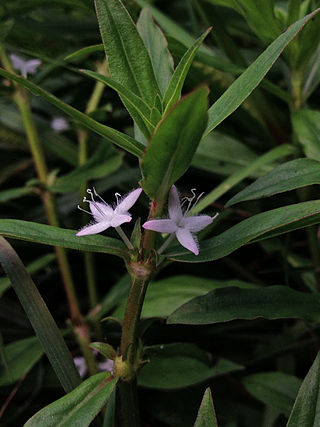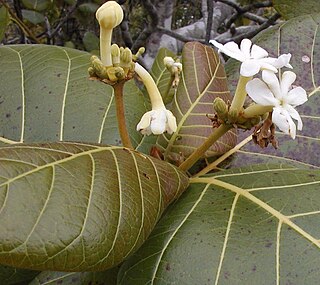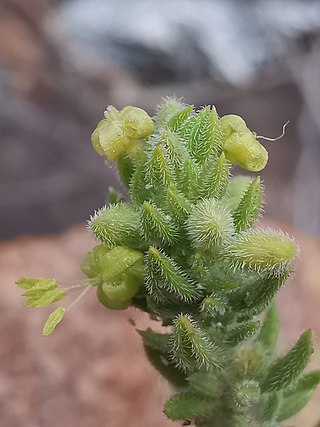
Diodia is a genus of flowering plants in the family Rubiaceae. It was described by Carl Linnaeus in 1753. The genus is found from southern and eastern United States, South America, Central America, Mexico, the West Indies and tropical Africa.
Stenostomum sintenisii, synonym Antirhea sintenisii, is a species of plant in the family Rubiaceae. It is endemic to Puerto Rico.

Casasia is a genus of flowering plants in the family Rubiaceae. These shrubs or small trees occur on the Caribbean islands and in one case in Florida. Some of the ten accepted species were formerly placed elsewhere, e.g. in the related genip-tree genus (Genipa), in Gardenia or in Randia.

Erithalis is a genus of flowering plants in the family Rubiaceae. The genus is found from southern Florida to tropical America.

Exostema is a genus of flowering plants in the family Rubiaceae. It consists of trees and shrubs, endemic to the neotropics, with most of the species occurring in the West Indies.

Guettarda is a plant genus in the family Rubiaceae. Most of these plants are known by the common name velvetseed.

Rustia is a genus of flowering plants in the family Rubiaceae. There are 17 species distributed in tropical Central and South America. They are shrubs and trees up to 15 metres (49 ft) tall.

Rondeletia is a genus of flowering plants in the family Rubiaceae. It is endemic to the Neotropics. There are around 160 species.

Spermacoce or false buttonweed is a genus of flowering plants in the family Rubiaceae. It comprises about 275 species found throughout the tropics and subtropics. Its highest diversity is found in the Americas, followed by Africa, Australia and Asia.
Acrosynanthus is a genus of flowering plants in the family Rubiaceae. It is found in Cuba and Jamaica in the Caribbean.

Chiococceae is a tribe of flowering plants in the family Rubiaceae which contains about 233 species in 27 genera. Most representatives occur from southern Florida to tropical and subtropical America, except for the genera Badusa and Bikkia, which are found from the Philippines to the West Pacific, and Morierina and Thiollierea, which are native to New Caledonia. The tribe Catesbaeeae is now included within Chiococceae.

Rondeletieae is a tribe of flowering plants in the family Rubiaceae and contains about 178 species in 8 genera. Its representatives are found from southern Mexico to northern South America and in the Caribbean.
Nernstia is a monotypic genus of flowering plants in the family Rubiaceae. It was described by Ignatz Urban in 1923.

Chimarrhis is a genus of flowering plants in the family Rubiaceae. It has 15 recognized species, native to Central America, South America and the West Indies.

Anthospermeae is a tribe of flowering plants in the family Rubiaceae and contains 208 species in 12 genera. Its representatives are found in the Southern Hemisphere, with the exception of the two species of the genus Phyllis. At least two genera, namely Coprosma and Galopina are anemophilous.
Casasia domingensis is a plant native to the Dominican Republic, it is a part of the family Rubiaceae.
Casasia haitensis is a species of plant that is native to Haiti. It belongs to the family Rubiaceae.
Schmidtottia is a genus of flowering plants in the family Rubiaceae, native to eastern Cuba. Adapted to serpentine soils, they are nickel hyperaccumulators.
Tobagoa is a genus of flowering plants belonging to the family Rubiaceae.
Micrasepalum is a genus of flowering plants belonging to the family Rubiaceae.









